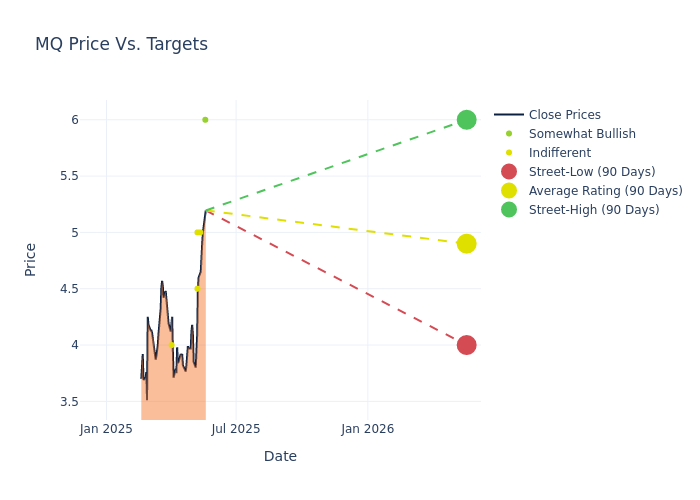What Analysts Are Saying About Marqeta Stock
Marqeta (NASDAQ:MQ) has been analyzed by 6 analysts in the last three months, revealing a diverse range of perspectives from bullish to bearish.
The following table summarizes their recent ratings, shedding light on the changing sentiments within the past 30 days and comparing them to the preceding months.
| Bullish | Somewhat Bullish | Indifferent | Somewhat Bearish | Bearish | |
|---|---|---|---|---|---|
| Total Ratings | 0 | 1 | 5 | 0 | 0 |
| Last 30D | 0 | 1 | 0 | 0 | 0 |
| 1M Ago | 0 | 0 | 3 | 0 | 0 |
| 2M Ago | 0 | 0 | 1 | 0 | 0 |
| 3M Ago | 0 | 0 | 1 | 0 | 0 |
Analysts provide deeper insights through their assessments of 12-month price targets, revealing an average target of $4.83, a high estimate of $6.00, and a low estimate of $4.00. This upward trend is apparent, with the current average reflecting a 10.27% increase from the previous average price target of $4.38.

Exploring Analyst Ratings: An In-Depth Overview
A comprehensive examination of how financial experts perceive Marqeta is derived from recent analyst actions. The following is a detailed summary of key analysts, their recent evaluations, and adjustments to ratings and price targets.
| Analyst | Analyst Firm | Action Taken | Rating | Current Price Target | Prior Price Target |
|---|---|---|---|---|---|
| Tien-Tsin Huang | JP Morgan | Raises | Overweight | $6.00 | $5.00 |
| Ramsey El-Assal | Barclays | Raises | Equal-Weight | $5.00 | $4.00 |
| Timothy Chiodo | UBS | Raises | Neutral | $5.00 | $4.75 |
| Sanjay Sakhrani | Keefe, Bruyette & Woods | Raises | Market Perform | $4.50 | $4.00 |
| Will Nance | Goldman Sachs | Lowers | Neutral | $4.00 | $4.50 |
| Will Nance | Goldman Sachs | Raises | Neutral | $4.50 | $4.00 |
Key Insights:
- Action Taken: Analysts adapt their recommendations to changing market conditions and company performance. Whether they 'Maintain', 'Raise' or 'Lower' their stance, it reflects their response to recent developments related to Marqeta. This information provides a snapshot of how analysts perceive the current state of the company.
- Rating: Offering a comprehensive view, analysts assess stocks qualitatively, spanning from 'Outperform' to 'Underperform'. These ratings convey expectations for the relative performance of Marqeta compared to the broader market.
- Price Targets: Analysts navigate through adjustments in price targets, providing estimates for Marqeta's future value. Comparing current and prior targets offers insights into analysts' evolving expectations.
Capture valuable insights into Marqeta's market standing by understanding these analyst evaluations alongside pertinent financial indicators. Stay informed and make strategic decisions with our Ratings Table.
Stay up to date on Marqeta analyst ratings.
Delving into Marqeta's Background
Headquartered in Oakland, California, and founded in 2010, Marqeta provides its clients with a card-issuing platform that offers the infrastructure and tools necessary to offer digital, physical, and tokenized payment options without the need for a traditional bank. The company's open APIs are designed to allow third parties like DoorDash, Klarna, and Block to rapidly develop and deploy innovative card-based products and payment services without the need to develop the underlying technology. The company generates revenue primarily through processing and ATM fees for cards issued on its platform.
Marqeta: Financial Performance Dissected
Market Capitalization Analysis: Positioned below industry benchmarks, the company's market capitalization faces constraints in size. This could be influenced by factors such as growth expectations or operational capacity.
Revenue Growth: Over the 3M period, Marqeta showcased positive performance, achieving a revenue growth rate of 17.89% as of 31 March, 2025. This reflects a substantial increase in the company's top-line earnings. In comparison to its industry peers, the company stands out with a growth rate higher than the average among peers in the Financials sector.
Net Margin: The company's net margin is below industry benchmarks, signaling potential difficulties in achieving strong profitability. With a net margin of -5.94%, the company may need to address challenges in effective cost control.
Return on Equity (ROE): The company's ROE is below industry benchmarks, signaling potential difficulties in efficiently using equity capital. With an ROE of -0.8%, the company may need to address challenges in generating satisfactory returns for shareholders.
Return on Assets (ROA): Marqeta's ROA lags behind industry averages, suggesting challenges in maximizing returns from its assets. With an ROA of -0.59%, the company may face hurdles in achieving optimal financial performance.
Debt Management: Marqeta's debt-to-equity ratio is below the industry average. With a ratio of 0.01, the company relies less on debt financing, maintaining a healthier balance between debt and equity, which can be viewed positively by investors.
The Core of Analyst Ratings: What Every Investor Should Know
Analysts are specialists within banking and financial systems that typically report for specific stocks or within defined sectors. These people research company financial statements, sit in conference calls and meetings, and speak with relevant insiders to determine what are known as analyst ratings for stocks. Typically, analysts will rate each stock once a quarter.
Analysts may enhance their evaluations by incorporating forecasts for metrics like growth estimates, earnings, and revenue, delivering additional guidance to investors. It is vital to acknowledge that, although experts in stocks and sectors, analysts are human and express their opinions when providing insights.
Breaking: Wall Street's Next Big Mover
Benzinga's #1 analyst just identified a stock poised for explosive growth. This under-the-radar company could surge 200%+ as major market shifts unfold. Click here for urgent details.
This article was generated by Benzinga's automated content engine and reviewed by an editor.
 Wall Street Journal
Wall Street Journal